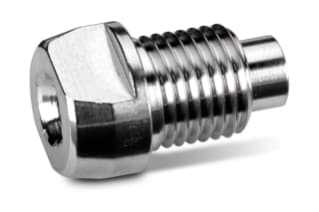
|
Chemistry |
C18 |
|
Separation Mode |
Reversed Phase |
|
Particle Substrate |
Hybrid |
|
pH Range Min |
2 pH |
|
pH Range Max |
11 pH |
|
Maximum Pressure |
18000 psi (1240 Bar) |
|
Endcapped |
Yes |
|
Bonding Technology |
Shield RP18 |
|
Silanol Activity |
Low |
|
Particle Shape |
Spherical |
|
Particle Size |
3.5 µm |
|
Endfitting Type |
Waters |
|
Pore Size |
130 Å |
|
Format |
VanGuard Cartridge |
|
Surface Area |
185 |
|
System |
HPLC |
|
Particle Technology |
BEH |
|
USP Classification |
L1 |
|
Inner Diameter |
2.1 mm |
|
Length |
5 mm |
|
Carbon Load |
17 % |
|
UNSPSC |
41115709 |
|
Brand |
XBridge |
|
Product Type |
Guards |
|
Units per Package |
3 pk |

XBridge BEH Shield RP18 VanGuard Cartridge, 130Å, 3.5 µm, 2.1 mm X 5 mm, 3/pk
VanGuard Cartridges are specially designed and tailored to protect and extend the life of analytical columns without compromising chromatographic performance. Each XBridge VanGuard configuration is well suited for the physical and chemical protection of the corresponding XBridge HPLC and UHPLC Columns it matches the formulation of. The interaction of chemical analysis with the analytical column reduces column lifetime and impairs chromatographic performance, particularly in the pharmaceutical, industrial chemical, environment, and natural goods industries.
XBridge BEH Shield RP18 VanGuard Cartridges are used to extend the lifetime and performance of analytical columns by removing particulate contamination from the mobile phase stream. This cartridge has been designed to protect all 2.1 mm and 3.0 mm I.D. XBridge BEH Shield RP18 analytical columns with 3.5 µm sorbent particles. Waters' VanGuard Column Protection products, such as the XBridge BEH Shield RP18 XP VanGuard Cartridge, help to improve analytical column performance by removing particles and chemical contamination from the mobile-phase stream.
The XBridge BEH Shield RP18 XP VanGuard Cartridge supports the XBridge BEH Shield RP18 XP Column thanks to the integrated Shield Technology, which is a great way to get better bases and has fewer interactions with basic analytes. This method creates a shielding effect in the sample by reducing interactions with basic analytes, which aids in the production of highly symmetrical, better peak morphologies, and efficient peaks. In comparison, other typical C18 columns have poor peak symmetry due to secondary interactions with basic chemicals and lacklustre cation exchange with leftover surface silanols.
You can easily shop for lab equipment that meets your needs by looking through our brochure or visiting our website. You should also review LCMS Certified Clear Glass 12 x 32 mm Screw Neck Vial, with Cap and Preslit PTFE/Silicone Septum, 2 mL Volume, 100/pk; All Waters LCMS Certified vials are manufactured using strictly controlled manufacturing and handling procedures. They are mass spectrometer tested and come with a certificate of analysis displaying the reference and vial scan for the manufacturing lot.
Why Might A Gradient System Be Necessary In Your Laboratory Set-Up?
To improve chromatographic separations, gradient systems allow you to control the flow rate and solvent/buffer changes. They can also be used to sharpen separations and speed up column re-equilibration. When equipped with methanol, acetonitrile, ammonium acetate buffer, and formic acid solution, a four-solvent gradient system is useful for method development. For rapid separations, quality control laboratories frequently employ isocratic systems that run a constant-composition premixed mobile phase.